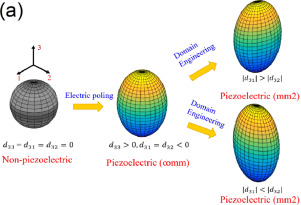当前位置:
X-MOL 学术
›
Acta Mater.
›
论文详情
Our official English website, www.x-mol.net, welcomes your
feedback! (Note: you will need to create a separate account there.)
Quantitative domain engineering for realizing d36 piezoelectric coefficient in tetragonal ceramics
Acta Materialia ( IF 8.3 ) Pub Date : 2020-04-01 , DOI: 10.1016/j.actamat.2020.02.031 Jingen Wu , Zhongqiang Hu , Xiangyu Gao , Zhaoqiang Chu , Guohua Dong , Zhiguang Wang , Bin Peng , Ren-Ci Peng , Ziyao Zhou , Shuxiang Dong , Ming Liu
Acta Materialia ( IF 8.3 ) Pub Date : 2020-04-01 , DOI: 10.1016/j.actamat.2020.02.031 Jingen Wu , Zhongqiang Hu , Xiangyu Gao , Zhaoqiang Chu , Guohua Dong , Zhiguang Wang , Bin Peng , Ren-Ci Peng , Ziyao Zhou , Shuxiang Dong , Ming Liu

|
Abstract Piezoelectric devices based on d36 mode are remarkably stable that depolarization rarely occurs in d36 face shear mode, because d36 mode is completely different from d15 thickness shear mode, where the applied electric field is perpendicular to poling direction and depolarization is ineluctable due to 90° dipole rotation. However, piezoelectric ceramics conventionally possess three piezoelectric coefficients (i.e., d33, d31, and d15), while d36 only exists in single crystals of specific point groups and cut directions. In this work, we propose a method to realize d36 piezoelectric coefficient in tetragonal piezoelectric ceramics by mechanical and electric domain engineering. This method is successfully applied in bismuth scandium-lead titanate (abbreviated as BS-PT) high-temperature piezoelectric ceramics with a resultant d36 up to 160 pC/N, which broadens the application of BS-PT ceramics, such as face shear actuator, energy harvester, transducer, etc. We find that domain engineering by transversal electric poling is preferred compared with the transversal mechanical poling, due to the simpler process, higher reliability, and higher resultant d36 piezoelectric coefficient. By combining the Diffraction-Plane-Transformation (DPT) model with the domain engineering via transversal electric poling, we demonstrate a quantitative domain engineering method for the first time, which could be used for optimizing the piezoelectric properties by precise design of the domain structures in piezoelectric materials.
中文翻译:

实现四方陶瓷中d36压电系数的定量域工程
摘要 基于 d36 模式的压电器件非常稳定,在 d36 面剪切模式下很少发生去极化,因为 d36 模式与 d15 厚度剪切模式完全不同,d15 模式中施加的电场垂直于极化方向,并且由于 90° 去极化是不可避免的。偶极旋转。然而,压电陶瓷通常具有三个压电系数(即d33、d31和d15),而d36仅存在于特定点群和切割方向的单晶中。在这项工作中,我们提出了一种通过机械和电领域工程在四方压电陶瓷中实现 d36 压电系数的方法。该方法成功应用于钛酸铋钪铅(简称BS-PT)高温压电陶瓷,所得d36高达160 pC/N,拓宽了BS-PT陶瓷的应用,如面剪切致动器,能量采集器、换能器等。我们发现与横向机械极化相比,横向电极化的域工程是首选,因为它的工艺更简单,可靠性更高,产生的 d36 压电系数更高。通过将衍射平面变换 (DPT) 模型与通过横向电极化的域工程相结合,我们首次展示了一种定量域工程方法,该方法可用于通过精确设计域结构来优化压电性能。压电材料。这拓宽了 BS-PT 陶瓷的应用,如面剪切致动器、能量收集器、换能器等。 我们发现与横向机械极化相比,横向电极化的域工程是首选,由于工艺更简单,可靠性更高,和更高的合成 d36 压电系数。通过将衍射平面变换 (DPT) 模型与通过横向电极化的域工程相结合,我们首次展示了一种定量域工程方法,该方法可用于通过精确设计域结构来优化压电性能。压电材料。这拓宽了 BS-PT 陶瓷的应用,如面剪切致动器、能量收集器、换能器等。 我们发现与横向机械极化相比,横向电极化的域工程是首选,由于工艺更简单,可靠性更高,和更高的合成 d36 压电系数。通过将衍射平面变换 (DPT) 模型与通过横向电极化的域工程相结合,我们首次展示了一种定量域工程方法,该方法可用于通过精确设计域结构来优化压电性能。压电材料。我们发现,与横向机械极化相比,横向电极化的域工程更受欢迎,因为它具有更简单的工艺、更高的可靠性和更高的 d36 压电系数。通过将衍射平面变换 (DPT) 模型与通过横向电极化的域工程相结合,我们首次展示了一种定量域工程方法,该方法可用于通过精确设计域结构来优化压电性能。压电材料。我们发现,与横向机械极化相比,横向电极化的域工程更受欢迎,因为它具有更简单的工艺、更高的可靠性和更高的 d36 压电系数。通过将衍射平面变换 (DPT) 模型与通过横向电极化的域工程相结合,我们首次展示了一种定量域工程方法,该方法可用于通过精确设计域结构来优化压电性能。压电材料。
更新日期:2020-04-01
中文翻译:

实现四方陶瓷中d36压电系数的定量域工程
摘要 基于 d36 模式的压电器件非常稳定,在 d36 面剪切模式下很少发生去极化,因为 d36 模式与 d15 厚度剪切模式完全不同,d15 模式中施加的电场垂直于极化方向,并且由于 90° 去极化是不可避免的。偶极旋转。然而,压电陶瓷通常具有三个压电系数(即d33、d31和d15),而d36仅存在于特定点群和切割方向的单晶中。在这项工作中,我们提出了一种通过机械和电领域工程在四方压电陶瓷中实现 d36 压电系数的方法。该方法成功应用于钛酸铋钪铅(简称BS-PT)高温压电陶瓷,所得d36高达160 pC/N,拓宽了BS-PT陶瓷的应用,如面剪切致动器,能量采集器、换能器等。我们发现与横向机械极化相比,横向电极化的域工程是首选,因为它的工艺更简单,可靠性更高,产生的 d36 压电系数更高。通过将衍射平面变换 (DPT) 模型与通过横向电极化的域工程相结合,我们首次展示了一种定量域工程方法,该方法可用于通过精确设计域结构来优化压电性能。压电材料。这拓宽了 BS-PT 陶瓷的应用,如面剪切致动器、能量收集器、换能器等。 我们发现与横向机械极化相比,横向电极化的域工程是首选,由于工艺更简单,可靠性更高,和更高的合成 d36 压电系数。通过将衍射平面变换 (DPT) 模型与通过横向电极化的域工程相结合,我们首次展示了一种定量域工程方法,该方法可用于通过精确设计域结构来优化压电性能。压电材料。这拓宽了 BS-PT 陶瓷的应用,如面剪切致动器、能量收集器、换能器等。 我们发现与横向机械极化相比,横向电极化的域工程是首选,由于工艺更简单,可靠性更高,和更高的合成 d36 压电系数。通过将衍射平面变换 (DPT) 模型与通过横向电极化的域工程相结合,我们首次展示了一种定量域工程方法,该方法可用于通过精确设计域结构来优化压电性能。压电材料。我们发现,与横向机械极化相比,横向电极化的域工程更受欢迎,因为它具有更简单的工艺、更高的可靠性和更高的 d36 压电系数。通过将衍射平面变换 (DPT) 模型与通过横向电极化的域工程相结合,我们首次展示了一种定量域工程方法,该方法可用于通过精确设计域结构来优化压电性能。压电材料。我们发现,与横向机械极化相比,横向电极化的域工程更受欢迎,因为它具有更简单的工艺、更高的可靠性和更高的 d36 压电系数。通过将衍射平面变换 (DPT) 模型与通过横向电极化的域工程相结合,我们首次展示了一种定量域工程方法,该方法可用于通过精确设计域结构来优化压电性能。压电材料。











































 京公网安备 11010802027423号
京公网安备 11010802027423号